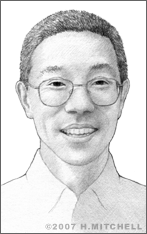Yet-Ming Chiang
Materials scientist Yet-Ming Chiang has developed breakthrough materials to enable new technologies such as stable, high-power, rechargeable batteries and novel electrochemical actuators. Thanks to his research, reusable batteries are now available that are safer and more powerful than earlier lithium-ion rechargeable varieties and are relatively inexpensive to produce.
Born in Kaohsiung, Taiwan on April 25, 1958, Chiang emigrated to the United States with his family when he was six years old. He spent much of his childhood in Connecticut and became a naturalized citizen of the U.S. at age 16. He entered the Massachusetts Institute of Technology (MIT) as a materials science and engineering student, where he conducted research in the laboratory of the late professor W. David Kingery, a 1999 recipient of the Kyoto Prize, as a participant in MIT’s Undergraduate Research Opportunities Program. Chiang completed his SB degree in 1980, followed by an ScD degree in Ceramics, also from MIT, in 1985.
In 1984, Chiang accepted a post as an assistant professor in MIT’s Material Science and Engineering department. In 1987, he co-founded American Superconductor, a company based in Westboro, Massachusetts, in order to make high-temperature, super-conducting wire for energy and power applications. MIT offered him tenure in 1990, making him the youngest tenured professor in the history of his department. He was promoted to Full Professor in 1994.
Around that time, lithium-ion rechargeable batteries became widely available in the marketplace, offering better energy storage and environmental friendliness than commonly used alkaline batteries. Chiang began working on a recognized problem with lithium iron phosphate, the active material typically used in lithium-ion rechargeable batteries. Since the pure material is non-conductive, devices made with it use materials like lithium cobalt oxide for the positive electrode. In order to be safely usable, however, these batteries have power limitations that make them ineffective for many uses. Cobalt is also expensive.
Chiang realized that coating or otherwise treating the material was not enough to solve the issue. He began working on ways to alter the compound itself by adding small amounts of metal and using special techniques to process it. The result of his research was a breakthrough: nanoscale phosphate cathode material with high electronic conductivity that enables high power, safe chemistry, long life, and environmental soundness, at a relatively low cost. Chiang began working with partners to develop the product for mass production in 2002, when he took a year hiatus from MIT to co-found A123 Systems, based in Waltham, Massachusetts.
The firm got off the ground in November of 2005 and soon had its first customer, Black & Decker, which began producing DeWalt-brand power tools using A123’s M1 batteries. The devices are said to recharge to 90 percent in just five minutes. By 2006, A123 was producing nearly 6 million cells per year. Chiang’s technology also has potential uses in solar power, telecom, manufacturing, medical devices, and water purification systems. In addition, A123 is working to help hybrid bus and truck drive train system suppliers build solutions. It also supplies plug-in hybrid battery systems to several vehicle integrators.
Chiang’s latest research pertains to new electrochemical actuators that could be used to produce large-scale “morphing” structures, in other words, materials that could enable air, water, and land vehicles to change shape in order to improve performance and energy efficiency. The behavior would be similar to the way animals change the shape of their wings and flippers when they soar or dive. Chiang hopes that airplanes, boats, and helicopters could change the shape of their wings, rotors, and hulls in order to travel more efficiently.
The concept, which Chiang has worked on with MIT aeronautics and astronautics professor Steven Hall, comes directly out of findings from Chiang’s battery-related research. Chiang found that the charging and discharging that occurs in batteries causes ions to move, which causes battery electrode materials to expand and contract. Chiang and Hall tested a morphing model of a helicopter rotor blade containing a large number of lithium-ion batteries. By signaling the batteries to charge or discharge, operators can cause them to move a few millimeters, thereby forcing a shift in the rotor’s shape.
In 2010, Chiang co-founded 24M Technologies, where he continues to serve as Chief Scientist.
Chiang holds over a dozen patents and is the Kyocera Professor of Ceramics Chair in MIT’s Material Science and Engineering department, a title he has held since 1989. He has been named Fellow of the American Ceramic Society, has won awards from the ACS, including the Ross Coffin Purdy award, and was the 2006 recipient of an R&D 100 Award and the R&D 100 Editor’s Choice Award.


